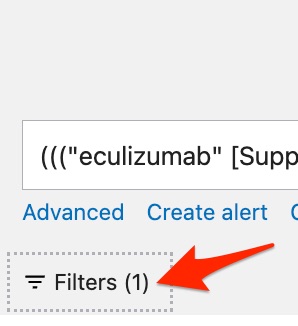Objective 2. Steps in a MeSH: Adding Filters
_______________________________________________________________________
Are you looking at pubMed results now?
You should now be looking at PubMed search results. The PubMed.gov logo should be present to the left of your search box. If you use the “Embolism and Thrombosis”[mesh], you should be looking at a list of over 55 results. If you used the “Thrombosis“[mesh], you should be looking at a list of 45 results or more.
_______________________________________________________________________
Step 7. Apply Filters
You want to find phase II, III, IV, and other randomized controlled trials.
- If you can’t see the filter column on the left-hand side of the page, click on the “Filters” button located beneath the search box to reveal the “filters” list.

- Start by applying the “Clinical Trial, Phase II”, “Clinical Trial, Phase III”, “Clinical Trials, Phase IV” and “Randomized Controlled Trial” article type filters. You may have to click the “See all article type filters’ to show all of these filters.

- If you want an “Article Language” or “Species” filter, you will have to click the “Additional Filters” button to make these filter options appear.
_______________________________________________________________________
Did you retrieve enough results to provide a good literature base for a formulary decision?
When this tutorial was last updated in August 2025, three articles were retrieved (if the “Embolism and Thrombosis”[MeSH] was used). This may be adequate, especially as more relevant articles will probably be identified by the keyword search for unindexed records that you will run later. If your search for unindexed records doesn’t identify any additional articles, you can always re-run your MeSH search and use the broader “clinical trial” filter instead of the “randomized controlled trial” filter.
_______________________________________________________________________
Step 8. Document your search strategy
It’s a good idea to copy the search history when you have completed a search and paste it into a Word document or e-mail. If you are then interrupted and have to leave the computer, you will have a record of the search strategy that you can copy and re-run easily.
- Click on the “Advanced” link under the search box.

- Find the row in your “History and Search Details” table that contains your “clinical trial-filtered” MeSH search.
- To simplify re-running the search later:
- Click the three-dot (ellipsis) icon in the “Actions” column.
- Select the “Add query” option

-
- Scroll up to the search box and copy the strategy from the search box. This form of the search strategy already includes the filters in a search-box friendly format.

-
- When you’re working on your group project, you will paste your copied strategy under the “1. MeSH…” heading in the required search strategy figure template (see template below with tutorial mesh search inserted in the appropriate spot). You may want to note the number of search results under the search strategy, but this isn’t required.
Search Strategies:
1. MeSH search for indexed PubMed (MEDLINE) records for Phase II-IV and randomized controlled trials**
(((“eculizumab” [Supplementary Concept]) AND “Hemoglobinuria, Paroxysmal”[Mesh]) AND “Embolism and Thrombosis”[Mesh]) AND “therapy” [Subheading] AND (clinicaltrialphaseii[Filter] OR clinicaltrialphaseiii[Filter] OR clinicaltrialphaseiv[Filter] OR randomizedcontrolledtrial[Filter]) AND (humans[Filter]) AND (english[Filter])
3 results
2 (optional). Keyword search for indexed PubMed (MEDLINE) records for Phase II-IV and randomized controlled trials** that cannot be identified by the MeSH search.
3. Keyword search for unindexed PubMed records for randomized controlled trials
4. Keywords search for unindexed and indexed PubMed records for meta-analyses and guidelines:
5. (optional) EMBASE search for records for Phase II-IV and randomized controlled trials:
6. (optional) ClinicalTrials.gov :
The following drug names were omitted from the keyword search strategies 2- 5 because they were used frequently to indicate discussion of irrelevant concepts and were causing retrieval of irrelevant results:
** If you are studying a rare disease and find few if any randomized controlled trials, search for any clinical trial instead of randomized controlled trials only and change the template headings accordingly.
